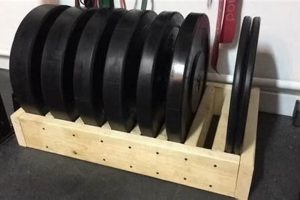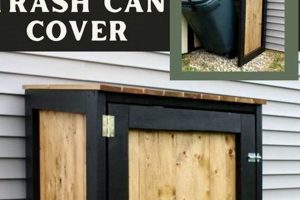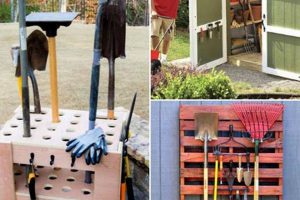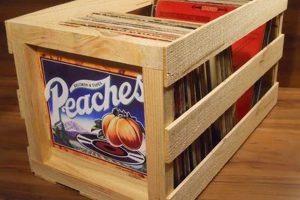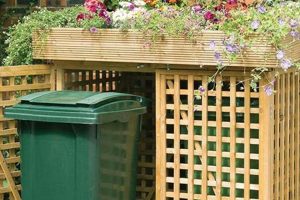Creative solutions for housing physical music media using self-made or modified components represent a practical approach to organizing and displaying vinyl record collections. These methods typically involve repurposing existing furniture, constructing new shelving units from raw materials, or employing inventive storage strategies to accommodate various collection sizes and spatial constraints. An example includes transforming wooden crates into stacked shelving, or utilizing wall-mounted picture ledges to showcase album covers.
Properly executed, these solutions protect delicate records from warping and damage, preserve archival value, and facilitate easy browsing. Historically, record collectors have sought innovative methods to manage their growing inventories. The drive for customization ensures that the storage directly reflects the individuals style and storage space. Moreover, it can present a more affordable alternative to commercially available options.
The following sections will detail various design concepts, essential construction considerations, and inspirational projects to optimize a vinyl record collection’s storage and visual appeal. Different space-saving techniques and design strategies that make storage units more effective will also be covered.
Storage Optimization Strategies
Efficient planning and execution are crucial when considering self-assembled solutions for vinyl record archival. The following points provide insights to ensure structural integrity and aesthetic appeal.
Tip 1: Measure Available Space Precisely: Prior to construction or modification, accurate measurements of the designated area are paramount. This step avoids size discrepancies and ensures seamless integration of the storage unit into the existing environment.
Tip 2: Prioritize Structural Integrity: When constructing shelving, select materials capable of supporting the weight of vinyl records. Reinforce joints with appropriate hardware and consider weight distribution to prevent sagging or collapse.
Tip 3: Ensure Proper Record Orientation: Store records vertically to prevent warping. Design shelving units with sufficient height and depth to accommodate album covers fully. Consider dividers every 4-6 inches to support and separate albums.
Tip 4: Incorporate Dividers for Organization: Using dividers within the storage solution enhances organization and allows for categorization by genre, artist, or other preferred metrics. Consistent spacing between dividers is recommended.
Tip 5: Consider Wall Mounting Options: Wall-mounted shelves conserve floor space and provide a visually appealing display option. Ensure that wall mounting hardware is appropriately rated for the anticipated weight load and securely attached to wall studs.
Tip 6: Incorporate Dust Protection: Consider dust covers or enclosing the front of the storage unit to protect records from airborne particles. Regular cleaning of the storage area also minimizes dust accumulation.
Tip 7: Factor in Future Expansion: Plan for future growth of the record collection. Design modular units that can be easily expanded or reconfigured as needed.
Implementing these guidelines will result in storage units that are both functional and aesthetically pleasing. Careful material selection, accurate measurements, and consideration of environmental factors enhance long-term archival capacity.
The next stage of the article explores specific designs and materials to enhance DIY strategies in detail.
1. Space Optimization
Space optimization is a paramount consideration within the realm of “diy vinyl record storage ideas.” Efficient utilization of available area directly impacts both the functional utility and aesthetic integration of the storage solution. Prudent planning maximizes capacity, prevents clutter, and contributes to the preservation of vinyl records through appropriate environmental control.
- Vertical Storage Solutions
Vertical shelving systems are frequently employed to maximize floor space. Stacking record crates or constructing wall-mounted shelving units allows collections to expand upwards, reducing the footprint occupied within the room. Such designs are particularly useful in smaller living spaces or apartments where horizontal area is limited.
- Multifunctional Furniture Integration
Incorporating record storage into existing or repurposed furniture represents another effective approach. Coffee tables, sideboards, or media consoles can be modified to include designated slots for vinyl records. This strategy serves a dual purpose, providing both storage and functional utility within a single furniture piece.
- Corner and Niche Exploitation
Underutilized corners and niches often present viable storage opportunities. Custom-built shelving units designed to fit these specific areas can effectively convert dead space into functional storage capacity. Triangular shelves or compact shelving configurations tailored to corner dimensions offer space-efficient solutions.
- Wall-Mounted Display Options
Wall-mounted solutions, beyond standard shelving, extend to picture ledges or floating shelves. These options showcase album artwork while minimizing spatial intrusion. Strategically positioned, these displays can act as visual focal points, enhancing the aesthetic appeal of the storage solution and the room itself.
The successful implementation of space optimization strategies within “diy vinyl record storage ideas” results in a collection storage solution that is both functional and visually integrated into its environment. These methods, whether focusing on vertical expansion, multifunctional furniture, niche exploitation, or wall-mounted display, ensure that records are stored efficiently while preserving valuable living space.
2. Material Selection
Material selection is a critical determinant in the success of any project centered around “diy vinyl record storage ideas.” The chosen material fundamentally impacts the storage unit’s structural integrity, aesthetic qualities, and long-term preservation capabilities. Inferior material may compromise stability, leading to damage to the record collection, while inappropriate materials can detract from the desired visual presentation. For instance, using untreated softwood for shelving could result in sagging under the weight of the records, causing potential warping and irreversible damage. Conversely, choosing durable hardwood or reinforced metal structures can ensure adequate support, protecting the valuable collection.
Beyond structural considerations, material selection directly influences the aesthetic integration of the storage solution within the living space. Options range from reclaimed wood for a rustic style to sleek metal for a modern aesthetic, each offering distinct visual characteristics. The decision to use a specific finish, such as varnish, paint, or stain, also affects the overall appearance and durability. Furthermore, material selection plays a role in archival preservation. Acid-free materials are preferred for lining shelves to prevent chemical reactions that could degrade album covers over time. Proper ventilation must also be considered to prevent moisture buildup, which could lead to mold growth. A practical example includes using sustainably sourced bamboo for its durability, moisture resistance, and aesthetic versatility.
Ultimately, the material selection process necessitates a comprehensive assessment of structural requirements, aesthetic preferences, and archival considerations. By carefully weighing these factors, a customized storage unit that not only protects the vinyl record collection but also enhances the surrounding environment can be realized. Neglecting this essential aspect can lead to structural failure, aesthetic mismatches, and potential damage to the valuable media. Prudent material evaluation directly correlates with the long-term success and aesthetic value of storage efforts.
3. Structural Stability
Structural stability is a foundational element within the domain of “diy vinyl record storage ideas.” The inherent weight of a vinyl record collection necessitates robust support to prevent structural failure and potential damage to the media. Inadequate construction or material selection directly compromises stability, leading to sagging shelves, collapse, and subsequent harm to the records. The domino effect of such a failure can extend beyond the collection itself, potentially causing damage to surrounding property or personal injury.
The correlation between structural stability and successful storage is directly proportional. Storage designed without sufficient load-bearing capacity invites structural failure. A common example involves the use of inexpensive particleboard or insufficiently reinforced shelving, which may initially appear adequate but gradually deform under the sustained weight of records. This deformation compromises the records’ vertical orientation, predisposing them to warping. Conversely, employing solid wood construction, reinforced joints, and appropriate bracing techniques can mitigate these risks. Considerations include the type of wood, its thickness, and the hardware used for assembly. Further, the support’s distribution is important, as wider shelves or spans need extra support, like a back panel or center support.
In conclusion, guaranteeing structural integrity is paramount when employing “diy vinyl record storage ideas.” Failure to prioritize this aspect can result in significant financial loss through damage to the vinyl collection, and potential safety hazards. Careful planning, prudent material selection, and employing robust construction techniques are essential investments in the long-term preservation and accessibility of a vinyl record collection. Neglecting structural integrity undermines the very purpose of storage: protection and preservation.
4. Aesthetic Integration
The seamless blending of storage solutions with existing interior design schemes is a crucial element within the conceptual framework of “diy vinyl record storage ideas.” Effective aesthetic integration enhances visual appeal, elevates the perception of the collection, and transforms functional storage into a deliberate design statement.
- Harmonizing with Existing Dcor
The color palette, material choices, and overall style of the storage unit should complement the room’s pre-existing design elements. Matching wood tones, echoing geometric patterns, or adopting a similar design language ensures that the storage does not appear as an intrusive addition but as an intentional component of the interior.
- Showcasing Album Artwork
Effective designs often highlight the visual appeal of vinyl record album covers. Open shelving, strategically placed lighting, and arrangements that allow covers to be seen transform the collection into a dynamic art display. This approach merges storage with aesthetic expression, elevating both the collection and the room’s visual interest.
- Employing Design Styles and Themes
Adopting a specific design style, such as mid-century modern, industrial, or minimalist, provides a cohesive framework for the storage solution. The chosen style dictates material choices, construction techniques, and overall form, ensuring that the storage aligns with broader design principles and personal preferences.
- Customization and Personalization
Allowing for customization, such as incorporating personal mementos, artwork, or integrated lighting, injects individuality into the storage unit. This personalized approach transcends mere functionality, transforming the storage into a reflection of personal taste and a curated expression of the owner’s identity.
These elementsharmonizing with dcor, showcasing artwork, adopting distinct styles, and facilitating personalizationcollectively contribute to a cohesive and visually appealing outcome within the realm of “diy vinyl record storage ideas.” The successful implementation of aesthetic integration elevates a functional storage solution into an intentional design element, enhancing the overall aesthetic experience of the space.
5. Accessibility
Ease of retrieval and return are paramount considerations in any storage solution. Accessibility, in the context of “diy vinyl record storage ideas,” dictates the functional utility of the storage and directly influences the frequency and ease with which the record collection is enjoyed. Poorly designed storage, despite being aesthetically pleasing or structurally sound, diminishes usability if records are difficult to locate or extract. The cause-and-effect relationship is direct: reduced accessibility leads to decreased engagement with the collection, undermining the purpose of storage.
Organized systems, such as alphabetical dividers or genre-based categorizations, enhance accessibility. Clear labeling and consistent shelving heights promote efficient browsing. Solutions such as pull-out shelves or rotating racks enable viewing and retrieval even from tightly packed storage areas. A practical example is a wall-mounted shelving unit designed with angled shelves, allowing the spines of the records to be easily visible and accessible. Conversely, storing records in deep, unlabeled boxes diminishes accessibility, transforming what should be an enjoyable activity into a frustrating chore. Considerations must also extend to physical limitations of the user, so elements like shelf height are important.
Effective storage solutions must balance preservation, organization, and ease of use. Maximizing accessibility translates to increased engagement with the vinyl record collection, justifying the effort invested in planning and construction. Challenges persist in optimizing accessibility within limited space or budget, but prioritizing this aspect ensures the storage fulfills its primary purpose: facilitating enjoyment of the stored media.
6. Protection
Within the realm of “diy vinyl record storage ideas,” protection assumes a role of paramount importance, directly influencing the long-term condition and playback quality of vinyl records. Inadequate preservation measures result in physical degradation, rendering the stored media unplayable or diminishing its auditory fidelity. Factors contributing to deterioration include exposure to ultraviolet radiation, extreme temperature fluctuations, excessive humidity, dust accumulation, and physical pressure exerted by improper storage techniques. The causal link is straightforward: insufficient protection begets diminished value and compromised auditory experience.
Proper storage solutions must mitigate these threats. UV-resistant materials or coatings shield records from light-induced fading and warping. Controlled environments, achieved through climate-controlled rooms or sealed storage containers, minimize temperature and humidity fluctuations. Regular cleaning of storage areas prevents dust accumulation, and vertical storage with appropriate dividers eliminates pressure-induced warping. Examples of protective DIY strategies include constructing shelving from solid wood to prevent sagging, lining shelves with acid-free paper to prevent chemical degradation of album covers, and utilizing dust covers or enclosed cabinets. Furthermore, placement of storage away from direct sunlight and heating/cooling vents is advisable.
Therefore, integrating protective measures is not merely an addendum to “diy vinyl record storage ideas” but rather a fundamental component. Prioritizing protection ensures the longevity and auditory integrity of the vinyl record collection, preserving its value and enabling continued enjoyment. Addressing the various environmental threats through appropriate design and material choices represents a sound investment in the preservation of this analog format.
7. Scalability
Scalability represents a critical consideration within the practical application of “diy vinyl record storage ideas.” The capacity to adapt to a growing collection directly influences the long-term viability and utility of any storage solution. Failure to account for future expansion can result in premature obsolescence, requiring complete reconstruction or the implementation of supplementary storage systems. Therefore, planning for scalability is an investment in the sustained functionality and aesthetic cohesion of the storage arrangement.
- Modular Design Principles
Employing modular design principles allows for the incremental expansion of storage capacity. Constructing individual units that can be stacked or interconnected provides a flexible framework for accommodating growth. An example would be building separate shelving modules that can be added horizontally or vertically as the collection expands. This approach mitigates the need for a complete overhaul of the storage system when capacity is exceeded.
- Expandable Shelving Systems
Implementing shelving systems designed with pre-planned expansion points facilitates seamless integration of new storage elements. Integrating additional support beams or pre-drilled holes allows for the addition of shelves or compartments without requiring extensive modification. For instance, constructing a basic frame with the provision for adding shelves at predetermined intervals ensures a cohesive aesthetic and efficient use of space as the collection grows.
- Convertible Space Utilization
Designing storage that can be adapted to accommodate varied collection sizes or formats enhances its scalability. Utilizing adjustable shelves, removable dividers, or reconfigurable compartments allows the storage unit to evolve alongside the collection. As an example, creating sections that can transition from storing standard LPs to accommodating box sets or larger format records provides a versatile solution for dynamic storage requirements.
- Strategic Material Selection
Choosing materials that can withstand increased weight loads and physical stress associated with a growing collection contributes to long-term scalability. Selecting robust materials and employing reinforced construction techniques ensures the storage unit remains structurally sound as it expands. This means considering the load-bearing capacity of wood or metal used in shelves, joints, and supporting structures, as these elements must be able to handle added weight without compromising stability.
These facets emphasize that scalability is an integral aspect of “diy vinyl record storage ideas.” By incorporating modular design principles, expandable shelving systems, convertible space utilization, and strategic material selection, a storage solution can be created that not only meets current needs but also anticipates future growth. This proactive approach ensures the sustained utility, aesthetic harmony, and structural integrity of the storage arrangement.
Frequently Asked Questions
The following section addresses common inquiries regarding the design, construction, and maintenance of record storage.
Question 1: What is the most crucial factor to consider when designing shelving?
Load-bearing capacity constitutes the most critical design parameter. Shelves must withstand the considerable weight of vinyl records without sagging or collapsing, ensuring the media’s protection.
Question 2: Which wood is most suitable for record storage?
Solid hardwoods, such as oak or maple, offer superior strength and durability. However, properly reinforced softwood alternatives, such as pine, may also be acceptable for cost-effectiveness.
Question 3: How should records be stored to prevent warping?
Vertical storage is paramount. Horizontal stacking exerts pressure on the records, increasing the risk of warping, particularly in environments with fluctuating temperatures.
Question 4: What is the optimum shelf depth for standard 12-inch records?
A shelf depth of approximately 13 inches provides adequate support for album covers and prevents records from protruding, safeguarding against accidental damage.
Question 5: How can dust accumulation be minimized in record storage?
Enclosed cabinets, dust covers, and regular cleaning practices effectively minimize dust accumulation. Implementing these strategies protects records from surface abrasion and potential playback interference.
Question 6: Is it possible to integrate lighting into storage?
Incorporating strategically positioned LED lighting enhances visibility and highlights album artwork. However, care must be taken to prevent heat buildup, which can negatively impact vinyl records.
Addressing these considerations promotes the construction and upkeep of reliable, functional, and visually appealing vinyl storage solutions.
The next segment presents a detailed walkthrough of a storage project, offering practical instruction.
Concluding Remarks
The preceding exploration of “diy vinyl record storage ideas” underscores the multifaceted nature of this undertaking. It reveals that successful archival of vinyl records hinges upon a synthesis of structural integrity, aesthetic consideration, environmental protection, and scalability planning. It emphasizes the importance of meticulous planning, thoughtful material selection, and robust construction methods. Failure to adequately address each of these elements can compromise the long-term condition and accessibility of the collection.
Implementing the principles outlined ensures that vinyl records are not merely stored but actively preserved and celebrated. Continued focus on innovation and refinement will undoubtedly lead to even more effective and aesthetically pleasing solutions for safeguarding these invaluable cultural artifacts, now and into the future.



